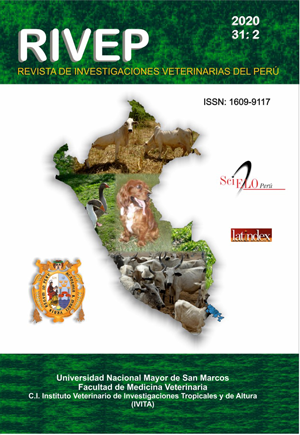Productive performance and morphometric characteristics and mineralization of tibia of broiler chickens supplemented with inorganic phosphates from five commercial sources
DOI:
https://doi.org/10.15381/rivep.v31i2.17843Keywords:
growing performance, tibia density, phosphorus, broilerAbstract
The aim of this study was to evaluate the productive performance of broilers and the morphometric characteristics and indicators of tibial mineralization as an effect of the inclusion of five sources of commercial inorganic phosphate in the diet. Three hundred male BB chickens from the Cobb 500 Line were used, randomly distributed in six treatments with 10 repetitions per treatment and five birds per repetition. The birds were fed for 21 days with the following diets: T1, basal diet + food grade monosodium phosphate (MNaP); T2, basal diet + dicalcium phosphate (DCP); T3, basal diet + monodicalcium phosphate 1 (MDCP 1); T4, basal diet + monodicalcium phosphate 2 (MDCP 2); T5: basal diet + monocalcium phosphate 1 (MCP 1); T6, basal diet + monocalcium phosphate 2 (MCP 2). Productive variables were recorded: body weight, weight gain, feed consumption and feed conversion. The birds were slaughtered at 21 days and the tibiae were removed to determine their morphometry (weight, length, diaphysis diameter and volume) and indicators of bone mineralization (density, Seedor index, robustness index and tibia resistance). Additionally, the percentages of ash, calcium and phosphorus in the tibia were determined. The treatments did not have a significant influence on the productive response of the birds, as well as on the bone morphometry and indicators of tibial mineralization. However, the percentage of P at the level of the tibia was affected (p<0.05) by the phosphate source used, with T2 (DCP) presenting the highest percentage. It is concluded that the phosphate source did not affect the productive performance, but that the DCP had a higher phosphorus retention in the tibia.
Downloads
Downloads
Published
Issue
Section
License
Copyright (c) 2020 Clara T. Murga, Jenny Virhuez R., Carlos Vílchez P., Luis Nakandakari A.

This work is licensed under a Creative Commons Attribution-NonCommercial-ShareAlike 4.0 International License.
AUTHORS RETAIN THEIR RIGHTS:
a. Authors retain their trade mark rights and patent, and also on any process or procedure described in the article.
b. Authors retain their right to share, copy, distribute, perform and publicly communicate their article (eg, to place their article in an institutional repository or publish it in a book), with an acknowledgment of its initial publication in the Revista de Investigaciones Veterinarias del Perú (RIVEP).
c. Authors retain theirs right to make a subsequent publication of their work, to use the article or any part thereof (eg a compilation of his papers, lecture notes, thesis, or a book), always indicating the source of publication (the originator of the work, journal, volume, number and date).



